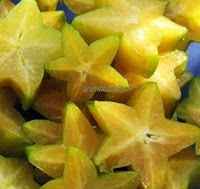THE LOCAL FRUIT is delicious and packed with nutrients. There are more tha 9 fruit species identified as commercial fruits for domestic and export potential. When it comes to fruit, many Malaysians tend to believe that the imports fruits are more nutritious than local ones. Even when fruits are sometimes and recommended to be included in our diet, more often than not, only imported ones are named. Due to this as reported that many consumers prefer apples, grapes or oranges compared to watermelons, starfruits or mangosteens. According to Pantai Hospital Kuala Lumpur dietitian kown as Pang Kang Ru says imported fruits may be more expensive but this does not mean they are any healthier. She said each type, whether local or imported has its unique nutritional value. For example, the rambutan has a higher content of vitamin C (38mg vitamin C/100g) compared to the blueberry (9.7mg vitamin C/100g). However, in terms of dietary fibre content, rambutan has only 0.3g of dietary fibre/100g while blueberries have 2.4g of dietary fibre per 100g. Each fruit is different for its nutrient content. No single fruit can provide all nutrients or provide superior nutrient contents than another. This article in "Anim Agriculture Technology" blog I discuss about tht local fruit that was tasty and good for health booster.
(5) MANGOSTEEN
Mangosteen (Garcinia mangostana) are among few popular fruits in Malaysia. There are two species of mangosteen in Malaysia known as Local Mangosteen and Mesta. The nutritional value (one serving) or three big mangosteen without skin and seeds (270g)are or three big and whole (1.1kg) include calories: 92kcal, dietary fibre: 13.8g, Fat: 2.7g, Protein: 1.6g, Potassium: 121.9mg, Vitamin C: 11.3mg and Calcium: 18.9mg. The reason to eat this fruit due to the rich in antioxidants, xanthones and fibre. The vitamins and minerals are important for bodily functions, including DNA production, muscle contraction, wound healing, immunity, and nerve signalling. Disease-fighting factor for this fruit include antioxidants such as xanthones found in mangosteen may help reduce oxidative stress by neutralising the free radicals. Xanthones also have anti-inflammatory, anti-bacterial and anti-cancer effects in several studies involving animals. However, more studies are needed to understand how this fruit may reduce inflammation in humans. Since fibre helps to promote healthy gut bacteria, consuming mangosteen may also improve immunity alongside other fruits as part of balanced diet. The best way to eat it include the white inner flesh can be eaten by itself or enjoyed in a smoothie or salad.
(6) STARFRUIT
(6) STARFRUIT
The Starfruit or Carambola (Averrhoa carambola) are unique trppical fruit grown in Malaysia. The nutritional value (one serving) of one medium (300g) reported consists of calories: 72kcal, dietary fibre: 5.4g, fat: 0.3g, protein: 2.1g, potassium: 297.4mg, vitamin A: 1502.7IU, vitamin C: 77.4mg, Beta-Carotene: 897.4mcg, calcium: 15mg and folate: 26.8mcg. The reason to eat starfruit include the relatively lower in calories (31kcal/100g) compared to other tropical fruits. It contain decent amount of fibre, vitamin A and C and potassium. Excellent source of healthy plant compounds, including quercetin, gallic acid, and epicatechin. It is approximately 90 per cent of water by weight which makes starfruit a good source for hydration. Disease-fighting factor due to the vitamin C has antioxidants properties; boosts the immune system; promotes healthy skin, hair and nails; and increases calcium uptake and iron absorption. The healthy plant compounds have powerful antioxidant properties and various health benefits. The best way to eat starfruit either on its own or add into salads. It can also be added in local dishes such as curries. It can be turned into jam or jelly as well as smoothies and juices.
This article divided in 4 segment namely Part 1, Part 2, Part 3 and Part 4 respectively. Thanks.
M Anim,
Putrajaya,
Malaysia.
(March 2021).




No comments:
Post a Comment